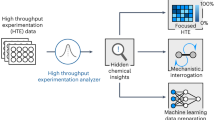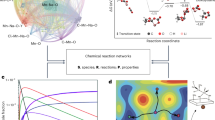Abstract
Reaction progress kinetic analysis (RPKA) is a simple, yet powerful method to assess and interrogate reactions. Under this paradigm, measurements of a reaction’s dynamic behavior over time help elucidate the underlying mechanism. In general, greater data density and variety allows deeper understanding to be realized; therefore, the successful application of RPKA relies on quick, reliable, and high density acquisition of reaction data furnished by analytical tools. However, each individual technique has its own limitations, creating a “blind spot” that limits the ability to delineate a reaction or process. These limitations can be circumvented through the application of multiple, orthogonal analyses, ensuring that the data collected is truly representative of the chemistry studied. While multiple measurements are routinely used to study a reaction mechanism, they are typically performed sequentially, with each analysis being compared against a second for validation. Alternatively, the simultaneous application of different analytical methods provides more information, leading to rapid mechanistic and kinetic understanding. This article will briefly review recent studies where the concomitant application of different analytical instruments has been used to acquire high-density and cross-validated reaction progress information. Moreover, these studies represent cases where the reactions are studied under “real-world,” synthetically-relevant conditions, which have led to actionable data to understand and optimize the chemical process.







































































































































































































Similar content being viewed by others
References
Blackmond DG (2015) Kinetic profiling of catalytic organic reactions as a mechanistic tool. J Am Chem Soc 137:10852–10866. doi:10.1021/jacs.5b05841
Blackmond DG (2005) Reaction progress kinetic analysis: a powerful methodology for mechanistic studies of complex catalytic reactions. Angew Chem Int Ed 44:4302–4320. doi:10.1002/anie.200462544
Mathew JS, Klussmann M, Iwamura H et al (2006) Investigations of Pd-catalyzed ArX coupling reactions informed by reaction progress kinetic analysis. J Org Chem 71:4711–4722. doi:10.1021/jo052409i
Wagner AJ, Rychnovsky SD (2013) Kinetic analysis of the HBTM-catalyzed esterification of an enantiopure secondary alcohol. Org Lett 15:5504–5507. doi:10.1021/ol402643n
Kubis C, Selent D, Sawall M et al (2012) Exploring between the extremes: conversion-dependent kinetics of phosphite-modified hydroformylation catalysis. Chem Eur J 18:8780–8794. doi:10.1002/chem.201200603
Sung S, Sale D, Braddock DC, Armstrong A (2016) Mechanistic Studies on the Copper-Catalyzed N-Arylation of Alkylamines Promoted by Organic Soluble Ionic Bases. ACS Catal 6:3965–3974. doi:10.1021/acscatal.6b00504
Mower MP, Blackmond DG (2015) Mechanistic rationalization of unusual sigmoidal kinetic profiles in the Machetti-De Sarlo cycloaddition reaction. J Am Chem Soc 137:2386–2391. doi:10.1021/ja512753v
Gehring T, Quaranta M, Odell B et al (2012) Observation of a transient intermediate in Soai’s asymmetric autocatalysis: insights from 1H NMR turnover in real time. Angew Chem Int Ed 51:9539–9542. doi:10.1002/anie.201203398
Buser JY, McFarland AD (2014) Reaction characterization by flow NMR: quantitation and monitoring of dissolved H2 via flow NMR at high pressure. Chem Commun 50:4234–4237. doi:10.1039/c4cc00055b
Brächer A, Hoch S, Albert K et al (2014) Thermostatted micro-reactor NMR probe head for monitoring fast reactions. J Magn Reson 242:155–161. doi:10.1016/j.jmr.2014.02.013
Vilhelmsen MH, Jensen J, Tortzen CG (2013) The Glaser–Hay reaction: optimization and scope based on 13 C NMR kinetics experiments. Eur J Org Chem 4:701–711. doi:10.1002/ejoc.201201159/pdf
Roslund MU, Aitio O, Wärnå J et al (2008) Acyl Group migration and cleavage in selectively protected β- d-galactopyranosides as studied by NMR spectroscopy and kinetic calculations. J Am Chem Soc 130:8769–8772. doi:10.1021/ja801177s
Foley DA, Doecke CW, Buser JY et al (2011) ReactNMR and ReactIR as reaction monitoring and mechanistic elucidation tools: the NCS mediated cascade reaction of α-thioamides to α-thio-β-chloroacrylamides. J Org Chem 76:9630–9640. doi:10.1021/jo201212p
Foley DA, Bez E, Codina A et al (2014) NMR Flow tube for online NMR reaction monitoring. Anal Chem 86:12008–12013. doi:10.1021/ac502300q
15. Zientek N, Meyer K, Kern S 2016 Quantitative online NMR spectroscopy in a nutshell. Chem Ing Tech 88:698–709. doi:10.1002/cite.201500120/pdf
Christianson MD, Tan EHP, Landis CR (2010) Stopped-flow Nmr: determining the kinetics of [rac-(C2H4(1-indenyl)2)ZrMe][MeB(C6F5) 3]-catalyzed polymerization of 1-hexene by direct observation. J Am Chem Soc 132:11461–11463. doi:10.1021/ja105107y
Foley DA, Dunn AL, Zell MT (2016) Reaction monitoring using online vs tube NMR spectroscopy: seriously different results. Magn Reson Chem 54:451–456. doi:10.1002/mrc.4259
Goswami M, Chirila A, Rebreyend C, Bruin B (2015) EPR spectroscopy as a tool in homogeneous catalysis research. Top Catal 58:719–750. doi:10.1007/s11244-015-0414-9
Grabow K, Bentrup U (2014) Homogeneous catalytic processes monitored by combined in Situ ATR-IR, UV–Vis, and Raman spectroscopy. ACS Catal 4:2153–2164. doi:10.1021/cs500363n
Rabeah J, Bentrup U, Stößer R (2015) Selective alcohol oxidation by a copper TEMPO catalyst: mechanistic insights by simultaneously coupled operando EPR/UV–Vis/ATR-IR spectroscopy. Angew Chem Int Ed 54:11791–11794. doi:10.1002/ange.201504813
Staško A, Milata V, Barbieriková Z (2014) Oxidation of quinolones with peracids (an in situ EPR study). Magn Reson Chem 52:22–26. doi:10.1002/mrc.4029/pdf
Squitieri RA, Shearn-Nance GP, Hein JE, Shaw JT (2016) Synthesis of esters by in situ formation and trapping of diazoalkanes. J Org Chem 81:5278–5284. doi:10.1021/acs.joc.6b00408
Leadbeater NE (2010) In situ reaction monitoring of microwave-mediated reactions using IR spectroscopy. Chem Commun 46:6693–6693. doi:10.1039/c0cc01921f
Calow ADJ, Carbó JJ, Cid J et al (2014) Understanding α,β-unsaturated Imine formation from amine additions to α,β-unsaturated aldehydes and ketones: an analytical and theoretical investigation. J Org Chem 79:5163–5172. doi:10.1021/jo5007366
Noedling AR, Muether K, Rohde VHG et al (2014) Ferrocene-stabilized silicon cations as catalysts for Diels–Alder reactions: attempted experimental quantification of Lewis acidity and ReactIR kinetic analysis. Organometallics 33:302–308. doi:10.1021/om401040y
Ley SV, Fitzpatrick DE, Myers RM et al (2015) Machine-assisted organic synthesis. Angew Chem Int Ed 54:10122–10136. doi:10.1002/anie.201501618
Ley SV, Fitzpatrick DE, Ingham RJ, Myers RM (2015) Organic synthesis: march of the machines. Angew Chem Int Ed 54:3449–3464. doi:10.1002/anie.201410744
Guerrero-Pérez MO, Bañares MA (2006) From conventional in situ to operando studies in Raman spectroscopy. Catal Today 113:48–57. doi:10.1016/j.cattod.2005.11.009
Schwolow S, Braun F, Rädle M, et al (2015) Fast and efficient acquisition of kinetic data in microreactors using in-line Raman analysis. Org Proc Res Dev 19:1286–1292. doi:10.1021/acs.oprd.5b00184
Bai R, Zhang G, Yi H et al (2014) Cu(II)–Cu(I) synergistic cooperation to lead the alkyne C–H activation. J Am Chem Soc 136:16760–16763. doi:10.1021/ja5097489
Chen X, Meece C, Gonzalez M, Chiang H (2013) Isoclast active manufacture: in situ spectroscopic investigation of the unstable products of cyanamide and sodium hypochlorite reactions. Org Proc Res Dev 19:139–144. doi:10.1021/op400290y
Zhou G, Moment A, Cuff J, Schafer W (2014) Process development and control with recent new FBRM, PVM, and IR. Org Proc Res Dev 19:227–235. doi:10.1021/op5000978
Fitzpatrick DE, Battilocchio C (2015) A novel internet-based reaction monitoring, control and autonomous self-optimization platform for chemical synthesis. Org Proc Res Dev 20:386–394. doi:10.1021/acs.oprd.5b00313
Müller S, Murat A, Maillos D (2015) Rapid Generation and safe use of carbenes enabled by a novel flow protocol with In-line IR spectroscopy. Chem Eur J 21:7016–7020. doi:10.1002/chem.201500416/pdf
Tolstoy PM, Koeppe B, Denisov GS, Limbach H-H (2009) Combined NMR and UV/Vis spectroscopy in the solution state: study of the geometries of strong OHO hydrogen bonds of phenols with carboxylic acids. Angew Chem Int Ed 48:5745–5747. doi:10.1002/anie.200806181
Fischer C, Beweries T, Preetz A, Drexler HJ (2010) Kinetic and mechanistic investigations in homogeneous catalysis using operando UV/Vis spectroscopy. Catal Today 155:282–288. doi:10.1016/j.cattod.2009.10.011
Koelewijn JM, Lutz M, Dzik WI, Detz RJ (2016) Reaction progress kinetic analysis as a tool to reveal ligand effects in Ce (IV)-driven IrCp*-catalyzed water oxidation. ACS Catal 6:3418–3427. doi:10.1021/acscatal.6b00297
Hein JE, Armstrong A, Blackmond DG (2011) Kinetic profiling of prolinate-catalyzed α-amination of aldehydes. Org Lett 13:4300–4303. doi:10.1021/ol201639z
Sung S, Sale D, Braddock DC et al (2016) Mechanistic studies on the copper-catalyzed N-arylation of alkylamines promoted by organic soluble ionic bases. ACS Catal 6:3965–3974.
Strieter ER, Bhayana B, Buchwald SL (2009) Mechanistic studies on the copper-catalyzed N-arylation of amides. J Am Chem Soc 131:78–88. doi:10.1021/ja0781893
Ruiz-Castillo P, Blackmond DG, Buchwald SL (2015) Rational ligand design for the arylation of hindered primary amines guided by reaction progress kinetic analysis. J Am Chem Soc 137:3085–3092. doi:10.1021/ja512903g
Burés J, Armstrong A, Blackmond DG (2016) Explaining anomalies in enamine catalysis: “downstream species” as a new paradigm for stereocontrol. Acc Chem Res 49:214–222. doi:10.1021/acs.accounts.5b00394
LeBars J, Dini S, Hawkins JM, Blackmond DG (2004) Mechanistic insights into anomalous kinetic behaviour in the hydrogenation of a substituted nitrobenzene. Adv Synth Catal 346:943–946. doi:10.1002/adsc.200303202
Hoover JM, Stahl SS (2011) Highly practical copper(I)/TEMPO catalyst system for chemoselective aerobic oxidation of primary alcohols. J Am Chem Soc 133:16901–16910. doi:10.1021/ja206230h
Hoover JM, Ryland BL, Stahl SS (2013) Mechanism of copper(I)/TEMPO-catalyzed aerobic alcohol oxidation. J Am Chem Soc 135:2357–2367. doi:10.1021/ja3117203
Littler BJ, Looker AR, Blythe TA (2010) Optimization of a hydrogenation process using real-time Mid-IR, heat flow and gas uptake measurements. Org Proc Res Dev 14:1512–1517. doi:10.1021/op100169j
Ryland BL, Stahl SS (2014) Practical aerobic oxidations of alcohols and amines with homogeneous copper/TEMPO and related catalyst systems. Angew Chem Int Ed 53:8824–8838. doi:10.1002/anie.201403110
Ryland BL, McCann SD, Brunold TC, Stahl SS (2014) Mechanism of alcohol oxidation mediated by Copper(II) and nitroxyl radicals. J Am Chem Soc 136:12166–12173. doi:10.1021/ja5070137
Knöpke LR, Nemati N, Köckritz A et al (2010) Reaction monitoring of heterogeneously catalyzed hydrogenation of Imines by coupled ATR-FTIR, UV/Vis, and Raman spectroscopy. ChemCatChem 2:273–280. doi:10.1002/cctc.200900273
Chung R, Yu D, Thai VT et al (2015) Tandem reaction progress analysis as a means for dissecting catalytic reactions: application to the Aza-Piancatelli rearrangement. ACS Catal 5:4579–4585. doi:10.1021/acscatal.5b01087
Veits GK, Wenz DR, Read de Alaniz J (2010) Versatile method for the synthesis of 4-aminocyclopentenones: dysprosium(III) triflate catalyzed Aza-Piancatelli rearrangement. Angew Chem Int Ed 49:9484–9487. doi:10.1002/anie.201005131
Palmer LI, Read de Alaniz J (2011) Direct and highly diastereoselective synthesis of azaspirocycles by a dysprosium(III) triflate catalyzed Aza-Piancatelli rearrangement. Angew Chem Int Ed 50:7167–7170. doi:10.1002/anie.201102102
Yu D, Thai VT, Palmer LI et al (2013) Importance of off-cycle species in the acid-catalyzed Aza-Piancatelli rearrangement. J Org Chem 78:12784–12789. doi:10.1021/jo402155b
Veits GK, Wenz DR, Palmer LI et al (2015) Cascade rearrangement of furylcarbinols with hydroxylamines: practical access to densely functionalized cyclopentane derivatives. Org Biomol Chem 13:8465–8469. doi:10.1039/C5OB00944H
Hoops S, Sahle S, Gauges R et al (2006) COPASI—a COmplex PAthway SImulator. Bioinformatics 22:3067–3074. doi:10.1093/bioinformatics/btl485
Yu D, Hein J unpublished results
Rougeot C, Situ H, Cao BH, Vlachos V, Hein JE (2017) Automated reaction progress monitoring of heterogeneous reactions: crystallization-induced stereoselectivity in amine-catalyzed aldol reactions. React Chem Eng. doi:10.1039/C1036RE00211K
Looker AR, Littler BJ, Blythe TA et al (2008) Development and manufacture of the Inosine monophosphate dehydrogenase inhibitor merimepodib, VX-497. Org Proc Res Dev 12:666–673. doi:10.1021/op800060h
Acknowledgements
The authors wish to thank the University of British Columbia, the National Science foundation (DMR-1359406) and the Natural Science and Engineering Research council of Canada (RGPIN-2016-04613) for operating funds. Additionally, graduate student fellowship (to R. C.) was provided by Pfizer Inc.
Author information
Authors and Affiliations
Corresponding author
Additional information
This minireview is dedicated to Professor Donna G. Blackmond on the occasion of her receiving the Gabor A. Samorjai Award for Creative Research in Catalysis.
Rights and permissions
About this article
Cite this article
Chung, R., Hein, J.E. The More, The Better: Simultaneous In Situ Reaction Monitoring Provides Rapid Mechanistic and Kinetic Insight. Top Catal 60, 594–608 (2017). https://doi.org/10.1007/s11244-017-0737-9
Published:
Issue Date:
DOI: https://doi.org/10.1007/s11244-017-0737-9




